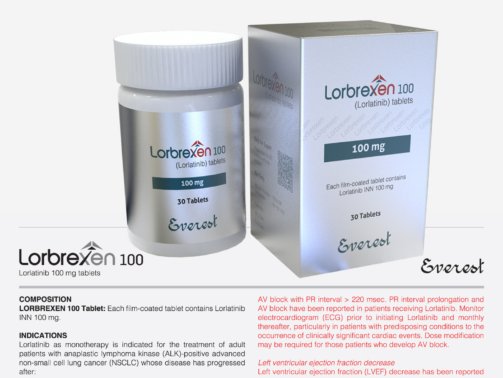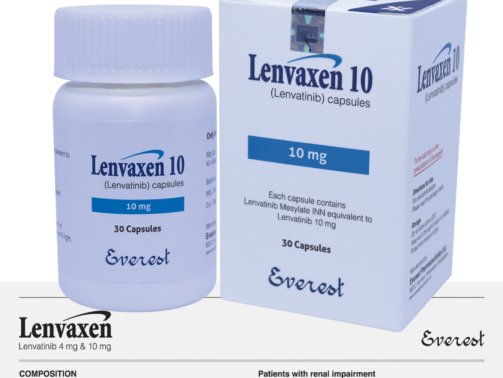- Fatigue
- Nausea
- Vomiting
- Peripheral edema (swelling of limbs)
- Increased liver enzymes (ALT, AST)
- Loss of appetite
Capmatinib, is a prescription oral drug that is marketed under the trade name Tabrecta and is categorized as a MET inhibitor. Treatment for specific forms of non-small cell lung cancer (NSCLC) is its main application. One of the common therapeutic dosages is 200 mg of capmatinib, which is essential for treating targeted cancer, particularly in individuals whose tumors contain particular genetic abnormalities.
Mechanism of Action
Capmatinib specifically suppresses the mesenchymal-epithelial transition (MET) receptor tyrosine kinase activity, which is implicated in a number of cellular functions, including migration, proliferation, and survival. Uncontrolled cell proliferation and the advancement of cancer are caused by dysregulation of the MET gene in certain malignancies, which frequently results from MET exon 14 skipping mutations or gene amplification. Cancer cells that rely on MET signaling can have their growth slowed or stopped by capmatinib’s inhibition of this pathway.
Indications
Capmatinib 200 mg is recommended for adult patients with metastatic non-small cell lung cancer (NSCLC) who have a mutation that causes MET exon 14 skipping, as identified by an FDA-approved test. It is usually recommended when MET exon 14 skipping is shown to be the main driving mutation and the disease has progressed or cannot be surgically eliminated.
Dosage and Administration
Two 200 mg tablets in the morning and two in the evening is the typical adult dosage of 400 mg taken orally twice a day. Food can be consumed with or without it. It is recommended that the tablets be consumed whole rather than broken, chewed, or split.
Depending on the liver function, side effects, patient tolerance, and interactions with other drugs, dose modifications can be necessary. Healthcare professionals keep a careful eye on patients to control any side effects that may occur during therapy and to guarantee the best dosage.
Side Effects and Precautions
Like all medications, Capmatinib can cause side effects. Common adverse reactions include:
Serious but less common side effects may include:
Patients with pneumonia or interstitial lung disease (ILD) should report any new or worsening respiratory symptoms right away.
Hepatotoxicity: Regular monitoring of liver function tests is necessary.
Patients with photosensitivity are encouraged to use protective gear and minimize their sun exposure.
Capmatinib should be used with caution in patients with pre-existing liver or kidney conditions. It is not recommended for use during pregnancy or breastfeeding due to potential harm to the fetus or infant.
Drug Interactions
Capmatinib is broken down by CYP3A enzymes, hence using it concurrently with potent CYP3A inducers or inhibitors should be done carefully. Drug levels in the body may be impacted by these interactions, which may also raise toxicity or decrease efficacy.
Storage
Capmatinib 200 mg tablets should be stored at room temperature, away from moisture and direct sunlight, and kept out of reach of children.
Order Now At Mdx Pharma bd….
To order from MDX Pharma BD, visit their website at https://mdxpharmabd.com, where you can browse products and place orders online. For inquiries or orders via email, contact emedicarepharma@gmail.com. Alternatively, call (+88) 01929123476. Their address is 29, Abdullahpur, Uttara, Dhaka-1230, Bangladesh.
1. How long does capmatinib take to start working?
82% of patients experienced an induced hematologic response with imatinib, and 69% of patients experienced sustained hematologic responses that lasted at least 4 weeks (complete in 34%). The main cytogenetic response rate was 24%, with 17% of cases being complete.
2. How quickly can metastases spread to the lungs?
Is the spread of lung cancer rapid? While some NSCLC tumors may never grow too much, others may double in size in as little as three weeks. Nevertheless, NSCLC has a doubling time of little more than seven months on average.
3. Can lung metastases lead to recovery?
Months are sometimes used to estimate survival in cases of lung metastases. However, some people can live for many years, particularly if the metastases are removed surgically.
4. Which organ experiences metastases first?
First, adjacent lymph nodes are affected first. The most frequent sites for solid tumor metastases are the brain, bones, liver, and lungs. Even though pain is a possible indication of advanced cancer, it is frequently not the initial one. However, some patients don’t exhibit any symptoms at all.
| Product Name | Capmaxen |
|---|---|
| Generic Name | Capmatinib INN |
| Formulation | Tablet |
| Available Pack Size | 56 Tablets |
| Available Strength | 200 mg |

 Cart is empty
Cart is empty 



